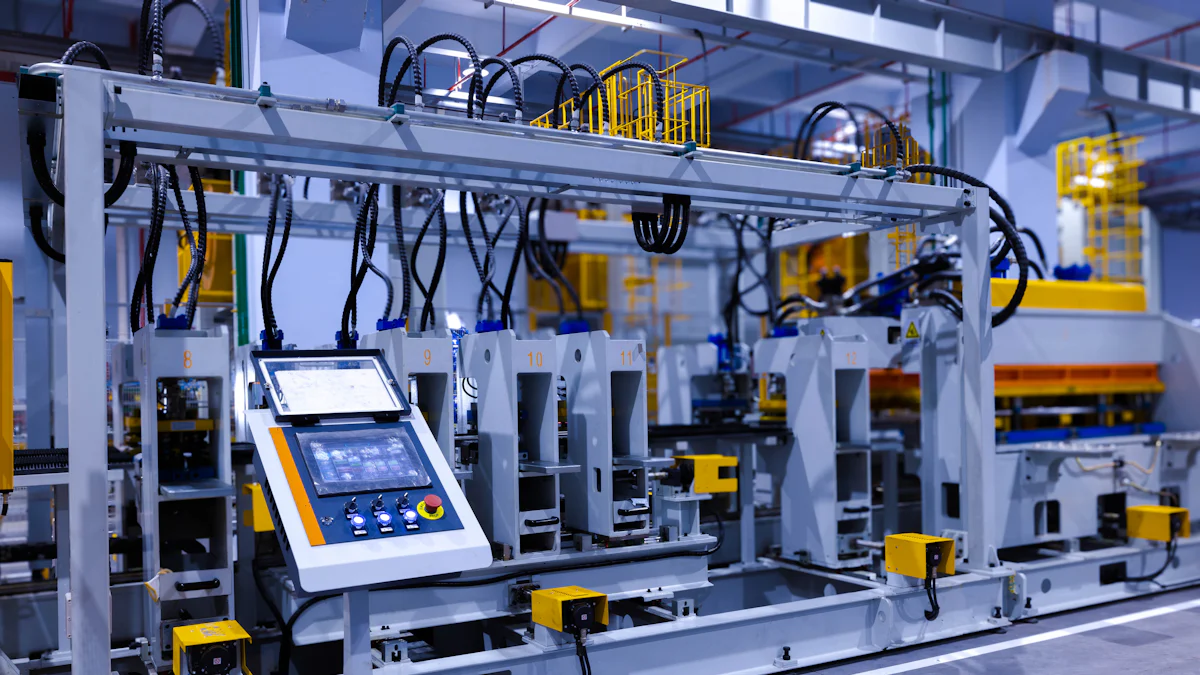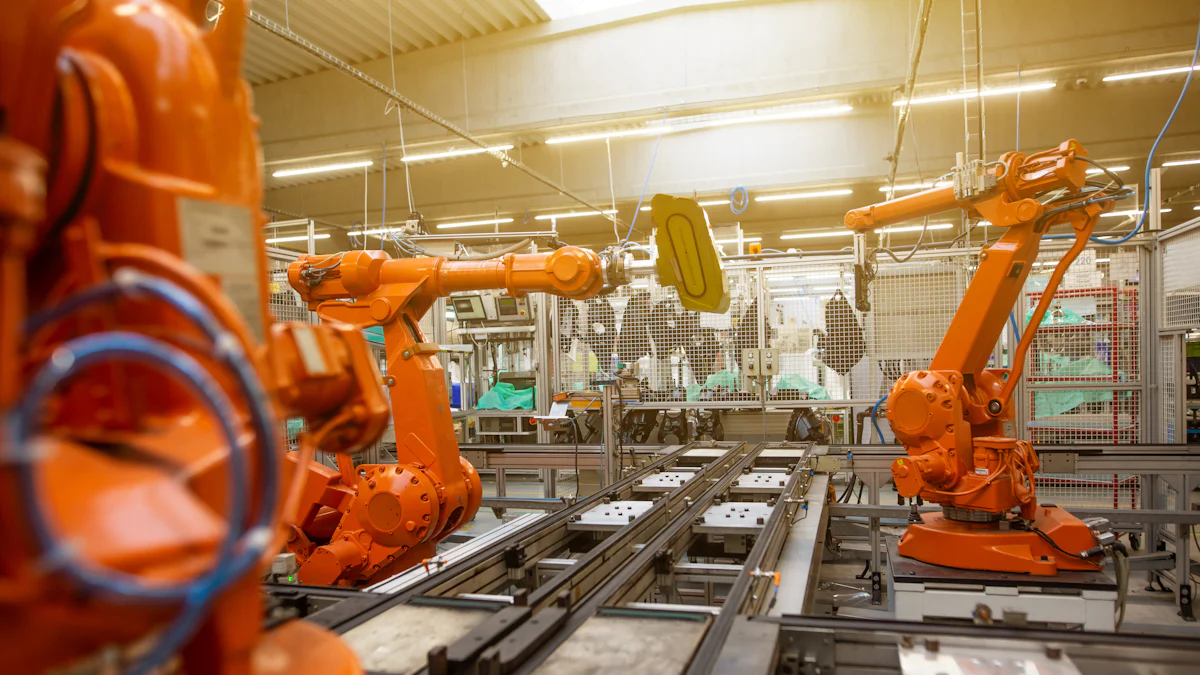Case Study Insights: Trend-Making in Modern Manufacturing

Trend-making holds critical importance in modern manufacturing. Companies must adapt to evolving market dynamics and consumer demands. Case study analysis provides valuable insights into these trends. For example, a 2021 study revealed that only 39% of manufacturing executives had successfully scaled data-driven use cases beyond the production process of a single product. This highlights the challenges and opportunities within the industry. The following sections will delve into detailed analyses, showcasing how companies leverage trend-making to drive innovation and sustainability.
The Evolution of Modern Manufacturing

Historical Context
Early Manufacturing Practices
Early manufacturing practices relied heavily on manual labor. Artisans crafted goods by hand, often in small workshops. Production rates were low, and quality varied significantly. The birth of modern manufacturing can be traced to Oliver Evans in the early 1780s. Evans introduced mechanized processes, reducing manpower by 25% while increasing output.
Industrial Revolution
The Industrial Revolution marked a significant shift. The invention and improvement of steam engines increased the volume of finished products. Fewer workers were needed, which streamlined production. The introduction of the assembly line by Ransom E. Olds in 1901 further revolutionized manufacturing. This innovation increased output by 500 percent in one year. In 1913, Henry Ford pioneered the moving assembly line, greatly accelerating the pace of manufacturing.
Technological Advancements
Automation and Robotics
Automation and robotics have transformed modern manufacturing. Automated systems perform repetitive tasks with high precision. Robots handle complex operations that require accuracy and speed. These technologies reduce human error and increase efficiency. Companies like Toyota Motor Corporation introduced lean manufacturing, streamlining production flow by reducing waste in several areas.
Internet of Things (IoT)
The Internet of Things (IoT) connects devices and systems within a manufacturing environment. IoT enables real-time monitoring and data collection. Manufacturers use this data to optimize processes and predict maintenance needs. IoT enhances communication between machines, leading to smarter and more responsive manufacturing systems.
Current Trends
Smart Factories
Smart factories represent the future of manufacturing. These facilities integrate advanced technologies like IoT, AI, and robotics. Smart factories enable real-time data analysis and decision-making. This leads to improved efficiency and reduced downtime. The adoption of smart manufacturing practices helps companies stay competitive in a rapidly evolving market.
Sustainable Manufacturing
Sustainable manufacturing focuses on reducing environmental impact. Companies implement green technologies to minimize waste and energy consumption. Supply chain optimization plays a crucial role in sustainability efforts. Manufacturers aim to create eco-friendly products and processes. Sustainable practices not only benefit the environment but also enhance brand reputation and customer loyalty.
Case Study: Implementing Smart Manufacturing
Company Background
Industry and Market Position
XYZ Corporation operates in the automotive industry. The company holds a significant market position due to its innovative approach and high-quality products. XYZ Corporation has a global presence, catering to diverse markets with varying demands.
Initial Challenges
XYZ Corporation faced several challenges before adopting smart manufacturing. The company struggled with inefficiencies in production processes. High error rates and frequent downtime affected overall productivity. Supply chain disruptions further complicated operations, leading to delays and increased costs.
Strategy and Implementation
Technology Adoption
XYZ Corporation decided to implement smart manufacturing technologies to overcome these challenges. The company integrated Internet of Things (IoT) devices to monitor equipment in real-time. IoT sensors provided valuable data on machine performance and maintenance needs. XYZ Corporation also adopted automation and robotics to handle repetitive tasks with precision. These technologies reduced human error and improved production speed.
Workforce Training
The successful implementation of smart manufacturing required workforce training. XYZ Corporation invested in upskilling employees to operate new technologies. Training programs focused on IoT systems, robotics, and data analytics. Employees learned to interpret data from IoT sensors and make informed decisions. This training ensured that the workforce could effectively utilize advanced technologies.
Results and Insights
Efficiency Gains
The adoption of smart manufacturing led to significant efficiency gains for XYZ Corporation. Real-time monitoring reduced downtime by 40%. Automation and robotics increased production capacity by 50%. The company also achieved a 30% reduction in operational costs. These improvements enhanced overall productivity and competitiveness.
Lessons Learned
XYZ Corporation's experience offers valuable insights for other manufacturers. The integration of smart manufacturing technologies requires careful planning and execution. Workforce training plays a crucial role in the successful adoption of new technologies. Companies must invest in upskilling employees to maximize the benefits of smart manufacturing. Additionally, real-time data analysis is essential for optimizing production processes and reducing downtime.
Case Study: Sustainable Manufacturing Practices
Company Background
Industry and Market Position
ABC Manufacturing operates in the electronics industry. The company has established a strong market position through innovation and quality. ABC Manufacturing serves global markets with diverse consumer demands.
Initial Challenges
ABC Manufacturing faced significant challenges before adopting sustainable practices. The company struggled with high energy consumption and waste production. Supply chain inefficiencies further complicated efforts to reduce environmental impact.
Strategy and Implementation
Green Technologies
ABC Manufacturing adopted several green technologies to address these challenges. The company implemented energy-efficient machinery to reduce power consumption. Solar panels were installed to harness renewable energy. ABC Manufacturing also invested in recycling systems to manage waste effectively.
Supply Chain Optimization
ABC Manufacturing restructured its supply chain for better sustainability. The company sourced materials from eco-friendly suppliers. Lean practices were introduced to minimize waste during production. ABC Manufacturing also optimized logistics to reduce carbon emissions.
Results and Insights
Environmental Impact
The adoption of sustainable practices led to significant environmental benefits. ABC Manufacturing reduced energy consumption by 30%. Waste production decreased by 25% due to effective recycling. The company also achieved a 20% reduction in carbon emissions through optimized logistics.
Lessons Learned
ABC Manufacturing's experience offers valuable insights for other manufacturers. The integration of green technologies requires careful planning and investment. Supply chain optimization plays a crucial role in achieving sustainability goals. Companies must collaborate with eco-friendly suppliers to ensure sustainable material sourcing. Lean practices help minimize waste and improve efficiency.
Future Trends in Manufacturing

Emerging Technologies
Artificial Intelligence
Artificial Intelligence (AI) continues to revolutionize the manufacturing industry. AI algorithms analyze vast amounts of data in real-time. This capability allows manufacturers to optimize production processes and predict maintenance needs. For instance, machine learning algorithms enable proactive measures like predictive maintenance, reducing downtime and enhancing efficiency. Companies like Alibaba and Lenovo invest heavily in AI to improve supply chain operations. AI-driven insights help manufacturers make smarter decisions, ensuring higher quality products.
3D Printing
3D Printing represents another transformative technology in manufacturing. This technology allows for the creation of complex parts with high precision. Manufacturers use 3D printing to produce prototypes quickly, reducing the time from design to production. The ability to create custom parts on-demand enhances flexibility and reduces inventory costs. Case studies show that 3D printing enables rapid product development and innovation. This technology also supports sustainable manufacturing by minimizing material waste.
Industry Predictions
Market Shifts
The manufacturing industry anticipates significant market shifts. Globalization and technological advancements drive these changes. Companies must adapt to evolving consumer demands and competitive pressures. Case studies reveal that manufacturers leveraging emerging technologies gain a competitive edge. The adoption of AI, IoT, and automation transforms traditional manufacturing models. These innovations enhance operational efficiency and product quality. Market shifts also include an increased focus on sustainability and eco-friendly practices.
Regulatory Changes
Regulatory changes will impact the future of manufacturing. Governments worldwide emphasize the importance of sustainability and environmental protection. Regulations aim to reduce carbon emissions and promote green technologies. Case studies highlight the benefits of adopting sustainable practices. Companies implementing green technologies achieve significant environmental and economic gains. Regulatory changes also encourage the localization of supply chains, enhancing resilience and reducing geopolitical risks.
Trend-making remains crucial in modern manufacturing. Companies must adapt to evolving market dynamics and consumer demands. Key takeaways from the case studies include:
Smart Manufacturing: Real-time monitoring and automation enhance efficiency and reduce costs.
Sustainable Practices: Green technologies and supply chain optimization lower environmental impact.
Future developments will likely focus on emerging technologies such as Artificial Intelligence and 3D Printing. These innovations promise to drive further advancements and sustainability in the industry. Manufacturers must stay informed and agile to remain competitive.
See Also
Unlocking Achievement: High-Tech Manufacturing Consultation Demystified
Guiding Efficient Transport for High-Tech Manufacturing Triumph
The Path to Manufacturing Excellence: Essential Tactics
Collaborate for Progress: Elevating Vendor Partnerships in High-Tech Manufacturing
Cutting-Edge Production: Dispelling Myths About Automation in High-Tech Manufacturing
